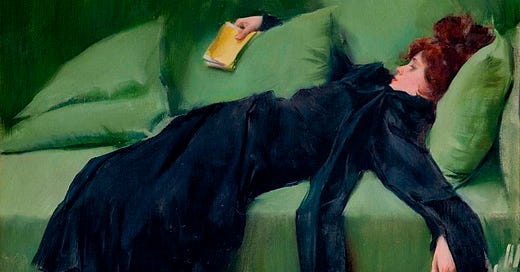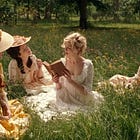19th century classics reading syllabus
an introduction and three month syllabus for 19th century literature
Two of my biggest identities are being an avid reader and a chronic planner. I thrive on structure and organizing things into categories. If you are like me, you’ll know that the purest form of happiness and peace sometimes comes from neurotically cataloging things. After having a sort of nostalgic epiphany, I decided to model my reading list like a college syllabus this year, or at least give myself a few themes and a general sense of what I want to learn from books (fiction and nonfiction alike). I’ve been on a mission to revive my intellectual curiosity and meaning in the books I re ad, so mindfully choosing a curation of books based on a specific season or theme has been massively helpful.
I mentioned on my “how to get smart again” post that I’ve been making that I’ve been making syllabi based on theme or time period, and many of you asked me to share those too, so here is the one I made for 19th century classic literature.
If you are looking to get into classics, the best place to start is looking into 19th century literature. I say this for two reasons: 1) the language is not much different to modern day language, compared to 17th-18th century literature that veers more towards Middle English or Early Modern English, and 2) the 19th century was a transformative century for literature in general, and the richness and depth that comes from its books is unparalleled. You can see this in the stark difference between books written in the early 19th century (Jane Austen’s bibliography) versus the late 19th century (The Picture of Dorian Gray).
Introduction to 19th Century Classic Literature
By the 19th century, English had pretty much standardized its grammar and vocabulary. There is not much difference between Early Modern English and Late Modern English apart from its vocabulary, which was in large part due to the Industrial Revolution—a key milestone in 19th century. The rapid growth and industrialization of the European continent propagated a plethora of new vocabulary and concepts to describe into words, most which were created with Latin and Greek linguistic roots. On top of this, the globalization of the world and expanding trade routes (on top of colonization, unfortunately) caused many foreign words to be adapted into the English language as its own.
Thematically, many books published were a response to the meteoric modernization and technological advances that were occurring, or the Enlightenment in the earlier decades of the century. The industrialization and urbanization inevitably led to a larger disparity in wealth and class, and much of the literature produced during this time critiqued this, reflecting on social inequalities and injustices. The industrial society that many countries were becoming was oftentimes a direct contention of artists and writers, who felt that the overwhelming emphasis on technology and mechanization was dehumanizing, stifling human connection and imagination, and destructing nature in general. The social impact of it, including the aforementioned wealth disparity and growing exploitation, especially of children, were also portrayed in many of the books.
The broad key movements of the 19th century are: Romanticism (Frankenstein, The Scarlet Letter, Byron’s poetry), Realism (Madame Bovary, Middlemarch, Huck Finn), and Modernism (Heart of Darkness, Portrait of a Lady—important to note that this movement flourished more and carried over into the early 20th century). There are other notable movements, such as Transcendentalism, Naturalism, and Aestheticism, but then this post would be way too long. You can check out some literary movements for yourself here—it makes for an excellent three hour rabbit hole.
I put two short books or one long book a week so depending on your reading speed, you can adjust the time it takes to finish the whole list! If you are a slow reader, you can double the time to make it a six month syllabus—it’s completely up to you. I tried to put a good mix of very famous classics and less famous classics that are all very interesting and worth reading alike. I also arranged it so that it goes from most readable to the densest (at least in my personal opinion), so anyone who wants to get into reading classics can sort of ease into it!





